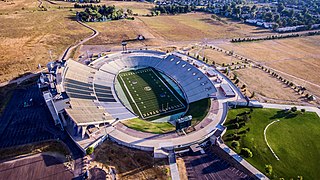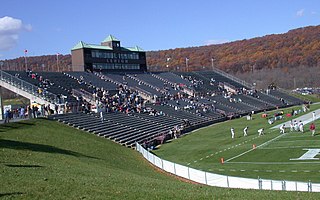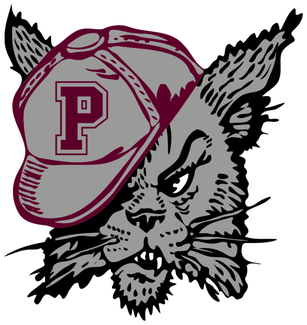
Rice Stadium is an American football stadium located on the Rice University campus in Houston, Texas. It has been the home of the Rice Owls football team since its completion in 1950, and hosted John F. Kennedy's "We choose to go to the Moon" speech in 1962 and Super Bowl VIII in early 1974.

Skelly Field at H. A. Chapman Stadium is an outdoor college football stadium in the south central United States, located on the campus of the University of Tulsa in Tulsa, Oklahoma. Commonly known as H. A. Chapman Stadium, it is the home field for the Tulsa Golden Hurricane of the American Athletic Conference.

Jordan-Hare Stadium is an American football stadium in Auburn, Alabama on the campus Auburn University. It primarily serves as the home venue of the Auburn Tigers football team. The stadium is named for Ralph "Shug" Jordan, who owns the most wins in school history, and Cliff Hare, a member of Auburn's first football team as well as Dean of the Auburn University School of Chemistry and President of the Southern Conference. On November 19, 2005, the playing field at the stadium was named in honor of former Auburn coach and athletic director Pat Dye. The venue is now known as Pat Dye Field at Jordan-Hare Stadium. The stadium reached its current seating capacity of 88,043 with the 2023 expansion and is the 12th largest stadium in the NCAA and the 21st largest in the world. For years, it has been a fixture on lists of best gameday atmospheres and most intimidating places to play.

Mountaineer Field at Milan Puskar Stadium is an American football stadium in Morgantown, West Virginia, on the campus of West Virginia University. It opened in 1980 and serves as the home field for the West Virginia Mountaineers football team. On the day the stadium opened, at an opening ceremony, John Denver touched down on the field in a helicopter, performed the song "Take Me Home, Country Roads," and then immediately departed by helicopter. The facility is named for Milan Puskar, a Morgantown resident and founder of Mylan Pharmaceuticals, Inc. who donated $20 million to the university in 2004. The playing surface retains the stadium's original name of Mountaineer Field, which was also the name of WVU's previous football stadium. The stadium’s design was inspired by Jack Trice Stadium, which opened a few years earlier at Iowa State University.

Aggie Memorial Stadium is an outdoor football stadium in the southwestern United States, located on the campus of New Mexico State University in Las Cruces, New Mexico. It is the home field of the New Mexico State Aggies of Conference USA.

Sonny Lubick Field at Hughes Stadium was an outdoor college football stadium in the western United States, located in Fort Collins, Colorado. It was the home field of the Colorado State Rams of the Mountain West Conference from 1968 through 2016; the team moved in 2017 to the new on-campus Colorado State Stadium.

Centennial Bank Stadium is a football stadium located in Jonesboro, Arkansas, on the campus of Arkansas State University that is home to the Arkansas State Red Wolves football team. The stadium opened in 1974 as Indian Stadium named after the old nickname of the school, the Indians, until the 2007 season when it was renamed ASU Stadium. The venue was renamed Liberty Bank Stadium in September 2012 after Liberty Bank of Arkansas donated approximately $5 million to the university. In 2013, Liberty Bank was bought by Home BancShares, whose trade name is Centennial Bank. Since 2015, the stadium has a seating capacity of 30,406.

Waldo Stadium is a stadium in Kalamazoo, Michigan. It is primarily used for football, and has been the home of Western Michigan University Broncos football in rudimentary form since 1914, and as a complete stadium since 1939. It currently has a capacity of 30,200 spectators.

Goodman Stadium is Lehigh University's 16,000-seat stadium located on its Goodman Campus in Lower Saucon Township, Pennsylvania. It opened in 1988, replacing Taylor Stadium, which stood in the main academic campus from 1914 until 1987. The former Taylor Stadium site now holds the Rauch Business Center, the Zoellner Arts Center, and a parking garage.

Nottingham Field is an 8,533-seat multi-purpose stadium in the western United States, located on the campus of the University of Northern Colorado in Greeley, Colorado. It is home to the Northern Colorado Bears football and track and field programs.

Phillipsburg High School is a comprehensive, four-year public high school located in Phillipsburg, in Warren County, in the U.S. state of New Jersey. Because of the town's proximity to the border between New Jersey and Pennsylvania the school's nickname is the "Stateliners." The school was first established in 1871. The school has been accredited by the Middle States Association of Colleges and Schools Commission on Elementary and Secondary Schools since 2000.

Easton Area High School is a large four-year public high school located in Easton, Pennsylvania in the Lehigh Valley area of eastern Pennsylvania. It is part of the Easton Area School District.

Roos Field is an outdoor college football stadium in the northwest United States, on the campus of Eastern Washington University in Cheney, Washington, southwest of Spokane. It is the home venue of the Eastern Washington Eagles of the Big Sky Conference in Division I (FCS).

Strawberry Stadium is a 7,408-seat football/soccer stadium in Hammond, Louisiana. It is home to the Southeastern Louisiana University Lions American football team. The stadium also hosts St. Thomas Aquinas Catholic High School football, previously hosted Hammond High School football, and has been the site of numerous play-off games involving other schools from Tangipahoa Parish.

The Rivalry is an American college football rivalry game played by the Lafayette Leopards football team of Lafayette College and the Lehigh Mountain Hawks football team of Lehigh University. It is the most-played football rivalry in the nation and is the longest uninterrupted rivalry game.

The Lafayette Leopards represent the 23 Division I varsity athletic teams of Lafayette College and compete in the Patriot League. There are 11 men's teams, 11 women's teams, and one co-ed team. The club teams also compete as the Leopards. Though not a varsity sport, crew and ice hockey are very competitive at Lafayette and play in intercollegiate club leagues.

Saluki Stadium is a stadium on the campus of Southern Illinois University in Carbondale, Illinois. It is primarily utilized by the Southern Illinois Salukis football team.
DU Stadium, sometimes referred to as Hilltop Stadium, was a stadium in the western United States, located on the campus of the University of Denver in Denver, Colorado. Built 98 years ago in 1926, the crescent-shaped main grandstand design on the west sideline was based on other similar-sized stadiums from the same time period, Brown Stadium and Cornell's Schoellkopf Field, both in the Ivy League.

The Lafayette Leopards football program represents Lafayette College in Easton, Pennsylvania in college football. One of the oldest college football programs in the United States, Lafayette currently plays in the Patriot League at the NCAA Division I Football Championship Subdivision level.
The 1926 Lafayette Leopards football team was an American football team that represented Lafayette College as an independent during the 1926 college football season. In its third season under head coach Herb McCracken, Lafayette compiled a 9–0 record and shut out five of nine opponents. Halfback Frank Kirkleski was the team captain.





















